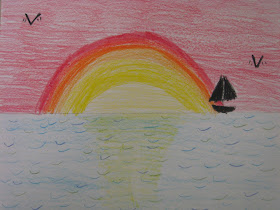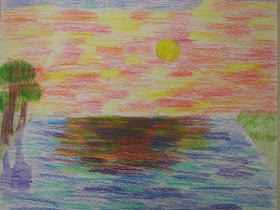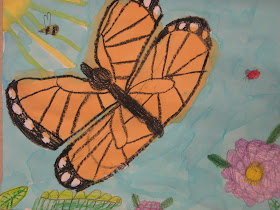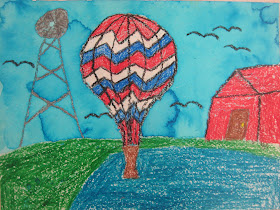My kindergartners are currently working through units on the elements of art shape and color. They painted sunsets using tempera cakes, and learned about how artists sometimes find creative ways to add beautiful colors to their artwork, like making a sunset sky instead of a solid blue sky. I gave each table three tempera cakes in colors that would blend well, to avoid having any mud-colored skies.
The water for the sailboat began with a review of lines they had learned earlier (a wavy line is the one we used here), and then they composed the sailboat out of shapes. We used regular tempera paints for the sailboat and water. The students learned to wash their brush in the water cup, and then pinch out the excess water, because unlike the tempera cakes we used for the sunset, the regular tempera paints should not have water added to them.
Next year, I might tie in some J. M. W. Turner art history into this lesson.
Here are some student results from the lesson:
Friday, September 30, 2016
Wednesday, September 28, 2016
5th Grade Sunset By the Water Paintings
My 5th grade students recently learned about Claude Monet's visit to Venice, Italy, where he created the famous painting San Giorgio at Dusk. While in Venice, Monet did not complete many paintings, because he concluded it was a city too beautiful to be painted. San Giorgio is a monastery island in Venice. The city of Venice is composed of 117 islands, most of which are connected by bridges. The monastery is alone, and not connected to any nearby islands. I asked the students why they thought that artists loved to paint sunsets by the water; the students rightly concluded that the reflections multiply the beautiful sunset colors! Then, I asked each students to use a ruler to create a horizon; then they could add any details that they wanted to create a sunset by the water. Their water could be a lake, stream, river, pond, ocean, or anything else they liked! Here are a few finished results from my 5th grade students.
Monday, September 19, 2016
2nd Grade Monarch Butterflies
I have taught this lesson to 1st graders and 2nd graders before; last time I posted it on my blog, I posted results from 1st grade. The success rate is a little higher with 2nd grade, and the number of students asking for help drops significantly, so I'm leaning toward keeping it as a 2nd grade lesson.
This lesson is in my unit on the principle of art pattern. I began by asking the students to think of animals with spots; then, I asked them to think of animals with lines. Then, I told them that I'm going to show them an animal with both spots and lines! Once the monarch was on the screen, the students noticed the spots around the edge of the wings, and the lines in the center. It looks complicated, but the lines actually make a loop, with lines extending from the loop like sun rays.
The students drew the monarch first, and then added any details that they wanted. I gave them a choice between coloring or painting their details; the only things they were required to paint were the blue sky and the orange butterfly (complementary colors make each other stand out!). Each table got a cup of liquid water colors in orange and blue; then they could ask for up to six other colors.
This lesson is in my unit on the principle of art pattern. I began by asking the students to think of animals with spots; then, I asked them to think of animals with lines. Then, I told them that I'm going to show them an animal with both spots and lines! Once the monarch was on the screen, the students noticed the spots around the edge of the wings, and the lines in the center. It looks complicated, but the lines actually make a loop, with lines extending from the loop like sun rays.
The students drew the monarch first, and then added any details that they wanted. I gave them a choice between coloring or painting their details; the only things they were required to paint were the blue sky and the orange butterfly (complementary colors make each other stand out!). Each table got a cup of liquid water colors in orange and blue; then they could ask for up to six other colors.
Wednesday, September 14, 2016
Kindergarten Fish
I posted two years ago about a hand-print fish lesson I taught my kindergartners. I have repeated the lesson last year and this year, because the results were good, and the students enjoyed it. Most of the fish turned out like this:
But, one student didn't quite get paint on part of the palm of her hand, and her fish came out with the mouth open! Sometimes we love happy accidents in art :). This painting made me smile!
But, one student didn't quite get paint on part of the palm of her hand, and her fish came out with the mouth open! Sometimes we love happy accidents in art :). This painting made me smile!
Tuesday, September 13, 2016
4th Grade Hot Air Balloons
I taught the lesson I posted yesterday to my 4th graders too! I'm actually much happier with their work than with the 5th graders....but that's a good thing, because I'm planning on keeping this as a 4th grade lesson in the future! I only taught it to both grades this year due to some other changes in my curriculum, which left a temporary gap in 5th grade, which will be filled with a different lesson next year. Enjoy my 4th grade students' paintings!
























































